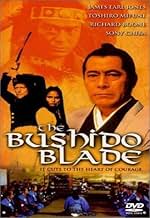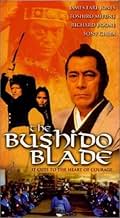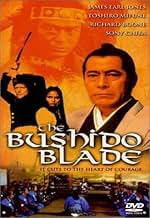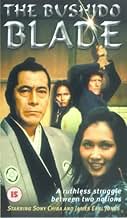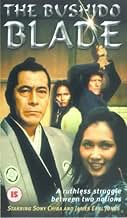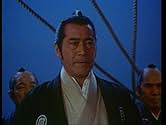PUNTUACIÓN EN IMDb
5,3/10
467
TU PUNTUACIÓN
Una espada samurái de acero que iba a ser entregada al embajador americano por el emperador de Japón es robada. Marineros estadounidenses y samuráis japoneses son enviados a buscarla.Una espada samurái de acero que iba a ser entregada al embajador americano por el emperador de Japón es robada. Marineros estadounidenses y samuráis japoneses son enviados a buscarla.Una espada samurái de acero que iba a ser entregada al embajador americano por el emperador de Japón es robada. Marineros estadounidenses y samuráis japoneses son enviados a buscarla.
- Dirección
- Guión
- Reparto principal
Mike Starr
- Bos'n Cave Johnson
- (as Michael Starr)
Timothy Patrick Murphy
- Midshipman Robin Burr
- (as Timothy Murphy)
Shin'ichi Chiba
- Prince Ido
- (as Sony Chiba)
Hitoshi Ômae
- Sumo
- (as Kin Omai)
Reseñas destacadas
It's always a little fascinating when a filmmaker undertakes a production at least partly outside their own country, and at least partly in another language. I would love the chance to read all about international co-productions like this, and learn how they came into being. What makes this instance particularly interesting, for good or maybe mostly for ill, is the ultimate form that it took, which is plainly evident very early on. Japanese filmmaker Kotani Tsugunobu may be directing (credited as "Tom Kotani"), and much of the picture may have been filmed in Japan with the cooperation of Toho. Why, much of the cast and crew is Japanese, including icons Mifune Toshiro and Sonny Chiba. Yet between the involvement of famed U. S. producers Rankin/Bass, and the screenplay of U. S. writer William Overgard, far more than not 'The bushido blade' absolutely feels from top to bottom like an exclusively Hollywood affair, and often in the worst of ways. This doesn't mean that it's not enjoyable - it is, to one degree or another - but the sincerity of it all is very much in question, and I'm also curious just how the contributors viewed their participation in retrospect.
Let's not beat around the bush: this does not treat Japan, its culture, or its people well. At best the feature offers a hopelessly simplified interpretation and depiction, and at worse the ignorant racism and jingoism of the nineteenth-century American characters is extended to the sensibilities with which the Japanese are portrayed. The Americans are roundly arrogant, with a conflated sense of self, virtue, and superiority; even when the script doesn't have the Americans specifically looking down on Japan as a backwards, quaint nation of "savages," the Americans are made out to be the definite heroes, and the Japanese to be the definite villains. And the thing is, despite the premise, there actually isn't a lot of room for nuance in this flick, for the characterizations are reduced and heavy-handed, if not purely archetypal or stereotypical - and the plot isn't far behind. One boyish, kindhearted sailor happens to have studied the language; his beefy uncle is much more physical and oafish; their designated leader will quizzically be dubbed an honorary samurai after being on Japanese soil for all of one day. One Japanese woman is soft and demure; one (played by Indonesian-Dutch actress Laura Gemser) is more dubious yet as she is The Fiery Warrior, The Warrior Poet, The Soft Woman, and The Romantic Interest all rolled into one.
I can forgive the very ahistorical story appended to a reimagined rendition of Commodore Perry arriving in Japan in the 1850s. I'm more concerned about the characters that fill discrete narrative roles, but without any hint of depth or nuance. I'm more concerned about how the scene writing flimsily tosses in sundry odds and ends that emphatically say "Japan!" for those viewers whose only experience with the Land of the Rising Sun is what they've seen or heard poorly represented on television: samurai, a violent code of honor, a long history of isolation, earthquakes. I'm certainly more concerned about how the plot at large seems rather loose, defined more by (a) some small set number of essential beats, and otherwise (b) general vibes, more than cogency, cohesiveness, or a mind for impactful drama or thrills. And I'm concerned by how even beyond conception and conjuration, the execution of this flick is wanting. Save for some nudity and greater levels of violence, this often comes across like the sort of highfalutin, "pip pip!" live-action adventure fare that Disney churned out in previous years. This sense comes from the writing, certainly, but also from the decided lack of polish in too many action sequences, as if professional stunt coordinators and fight choreographers weren't a thing. (At least "dueling master" Kuze Ryu shows that his involvement was not for nothing.) Sometimes it almost feels like Kotani was director in name only, and some unnamed American counterpart was actually in charge to see that all possible clichés and empty, tiresome tropes made their way in.
Sure, the filming locations are beautiful. The costume design is pretty sharp, and the production design and art direction. Some of the stunts and effects are better than others. It's reasonably well made. The movie is still entertaining to some extent, and I don't regret watching. But this needed so badly to be written and made more carefully, with more input from Kotani and Toho, and with less from Rankin/Bass. I don't know where precisely the responsibility lies for how this turned out, but I really have to wonder just how everyone felt about it when all was said and done as a title that frankly does a disservice to Japan and which in no meaningful way evinces anything except Hollywood with its all too common misrepresentations of This or That. Chiba is wasted here, and Mifune even more so; the same could surely be said for other stars. 'The bushido blade' is okay if you happen to come across it, but even if you're a huge fan of someone involved, there's no major reason to check it except as something light to pass the time on a quiet day. Maybe that's all it needed to be, but I expected something more solid and sure-footed.
Let's not beat around the bush: this does not treat Japan, its culture, or its people well. At best the feature offers a hopelessly simplified interpretation and depiction, and at worse the ignorant racism and jingoism of the nineteenth-century American characters is extended to the sensibilities with which the Japanese are portrayed. The Americans are roundly arrogant, with a conflated sense of self, virtue, and superiority; even when the script doesn't have the Americans specifically looking down on Japan as a backwards, quaint nation of "savages," the Americans are made out to be the definite heroes, and the Japanese to be the definite villains. And the thing is, despite the premise, there actually isn't a lot of room for nuance in this flick, for the characterizations are reduced and heavy-handed, if not purely archetypal or stereotypical - and the plot isn't far behind. One boyish, kindhearted sailor happens to have studied the language; his beefy uncle is much more physical and oafish; their designated leader will quizzically be dubbed an honorary samurai after being on Japanese soil for all of one day. One Japanese woman is soft and demure; one (played by Indonesian-Dutch actress Laura Gemser) is more dubious yet as she is The Fiery Warrior, The Warrior Poet, The Soft Woman, and The Romantic Interest all rolled into one.
I can forgive the very ahistorical story appended to a reimagined rendition of Commodore Perry arriving in Japan in the 1850s. I'm more concerned about the characters that fill discrete narrative roles, but without any hint of depth or nuance. I'm more concerned about how the scene writing flimsily tosses in sundry odds and ends that emphatically say "Japan!" for those viewers whose only experience with the Land of the Rising Sun is what they've seen or heard poorly represented on television: samurai, a violent code of honor, a long history of isolation, earthquakes. I'm certainly more concerned about how the plot at large seems rather loose, defined more by (a) some small set number of essential beats, and otherwise (b) general vibes, more than cogency, cohesiveness, or a mind for impactful drama or thrills. And I'm concerned by how even beyond conception and conjuration, the execution of this flick is wanting. Save for some nudity and greater levels of violence, this often comes across like the sort of highfalutin, "pip pip!" live-action adventure fare that Disney churned out in previous years. This sense comes from the writing, certainly, but also from the decided lack of polish in too many action sequences, as if professional stunt coordinators and fight choreographers weren't a thing. (At least "dueling master" Kuze Ryu shows that his involvement was not for nothing.) Sometimes it almost feels like Kotani was director in name only, and some unnamed American counterpart was actually in charge to see that all possible clichés and empty, tiresome tropes made their way in.
Sure, the filming locations are beautiful. The costume design is pretty sharp, and the production design and art direction. Some of the stunts and effects are better than others. It's reasonably well made. The movie is still entertaining to some extent, and I don't regret watching. But this needed so badly to be written and made more carefully, with more input from Kotani and Toho, and with less from Rankin/Bass. I don't know where precisely the responsibility lies for how this turned out, but I really have to wonder just how everyone felt about it when all was said and done as a title that frankly does a disservice to Japan and which in no meaningful way evinces anything except Hollywood with its all too common misrepresentations of This or That. Chiba is wasted here, and Mifune even more so; the same could surely be said for other stars. 'The bushido blade' is okay if you happen to come across it, but even if you're a huge fan of someone involved, there's no major reason to check it except as something light to pass the time on a quiet day. Maybe that's all it needed to be, but I expected something more solid and sure-footed.
"A swashbuckling Samurai saga that beats SHOGUN!" - Star Bulletin
Now, I bought a copy of this motion picture on video cassette that was released by Thorn-EMI Video, which means that the violence, beheadings, blood, and nudity are all intact as opposed to edited in the TV broadcast version.
The reason why I purchased it: I needed a test tape for VCR repair. For one dollar, you get an old tape where you wouldn't care if the machine decided to eat it!
Anyways, since I bought the tape and have also seen Shogun before, I figured I would give it a whurl. I have watched this movie and I'm glad I only spent one dollar on it!
While the premise of the story is certainly interesting enough, the low budget and TV-like production values doesn't do the premise any justice at all.
The acting feels badly forced at many points, which is also coupled with some rather claustrophobic cinematography, nervous direction, and snapshot editing. (It felt like I was watching a TV show that seemed to almost feel like "Hawaii Five-O" with all the pointless and quick zoom-ins to objects in the frame.)
The pacing felt somewhat uneven, perhaps to where it was trying to rush the story forward to reach the end sooner. This might explain the 92 minutes runtime on something that might have required up to 150 minutes to properly play in order to account for character relation to each other and their settings. In contrast, Paramount wisely produced Shogun as a television miniseries, as the original novel could simply not be condensed to even a four hour epic without losing too much. (Although, the re-editing of the miniseries with only a small helping of new footage in an attempt to make a motion picture out of Shogun was a very bad idea.)
There didn't seem to be very good interplay between the characters. The relationships that you may see develop in this picture tend to develop rather quickly and, therefore, unrealistically. The characters also seem somewhat simple and, in many ways, unbelievable. In concert with the atrocious acting, it made watching the characters about as appealing as watching a bad sci-fi movie without MST3K. In contrast, Shogun had characters that developed intricate interplay over a long period of time. They had shown themselves as complex individuals and continued to develop in the settings and with the other characters throughout the story.
Also, the one thing that caught me totally off-guard was the production company: Rankin-Bass.
Now, Rankin-Bass is a production company that is primarily responsible for children's programming. They had produced the animated version of "The Hobbit," "The Last Unicorn (1980s, ITC)," and "The King and I (1999, Warner Bros)," as well as producing various Christmas specials in the 1960s and 1970s like "Frosty, the Snowman" (Need to get to the north pole before melting), "Rudolph the Red Nosed Reindeer" (I don't want to wear a lump of coal on my nose!), "Little Drummer Boy," and "T'was the night before Christmas" (You know, the one with the singing clock to make Santa forgive a city for a letter written by some mouse who used "long words."). To those familiar with the 1980s, Rankin-Bass was also responsible for "Thundercats" and "Silverhawks."
Now, this did give a reason why the movie sucked as a whole: a production company with experience only with children's entertainment cannot hope to produce an R rated picture without creative difficulty.
Now, even though this film was co-produced with a British firm: Trident Films, the producer was Arthur Rankin Jr. himself. Jules Bass apparently did not have any involvement with this production.
Watch out for a cameo by James Earl Jones. Mako, Toshiro Mufune (who played in Shogun as well), and Sonny Chiba are other well regarded actors who starred in this movie.
If anything, try it for a rental and watch for yourself. This is assuming your local video store even has this movie for rent.
This movie does deserve some credit for at least trying to maintain a standard, although I would only give it one and half stars.
I might have given it worse, but watching REAL garbage like "Space Mutiny" and "Strategic Command" does make "Bushido Blade" and even "Xanadu" look decent. - Reinhart
Now, I bought a copy of this motion picture on video cassette that was released by Thorn-EMI Video, which means that the violence, beheadings, blood, and nudity are all intact as opposed to edited in the TV broadcast version.
The reason why I purchased it: I needed a test tape for VCR repair. For one dollar, you get an old tape where you wouldn't care if the machine decided to eat it!
Anyways, since I bought the tape and have also seen Shogun before, I figured I would give it a whurl. I have watched this movie and I'm glad I only spent one dollar on it!
While the premise of the story is certainly interesting enough, the low budget and TV-like production values doesn't do the premise any justice at all.
The acting feels badly forced at many points, which is also coupled with some rather claustrophobic cinematography, nervous direction, and snapshot editing. (It felt like I was watching a TV show that seemed to almost feel like "Hawaii Five-O" with all the pointless and quick zoom-ins to objects in the frame.)
The pacing felt somewhat uneven, perhaps to where it was trying to rush the story forward to reach the end sooner. This might explain the 92 minutes runtime on something that might have required up to 150 minutes to properly play in order to account for character relation to each other and their settings. In contrast, Paramount wisely produced Shogun as a television miniseries, as the original novel could simply not be condensed to even a four hour epic without losing too much. (Although, the re-editing of the miniseries with only a small helping of new footage in an attempt to make a motion picture out of Shogun was a very bad idea.)
There didn't seem to be very good interplay between the characters. The relationships that you may see develop in this picture tend to develop rather quickly and, therefore, unrealistically. The characters also seem somewhat simple and, in many ways, unbelievable. In concert with the atrocious acting, it made watching the characters about as appealing as watching a bad sci-fi movie without MST3K. In contrast, Shogun had characters that developed intricate interplay over a long period of time. They had shown themselves as complex individuals and continued to develop in the settings and with the other characters throughout the story.
Also, the one thing that caught me totally off-guard was the production company: Rankin-Bass.
Now, Rankin-Bass is a production company that is primarily responsible for children's programming. They had produced the animated version of "The Hobbit," "The Last Unicorn (1980s, ITC)," and "The King and I (1999, Warner Bros)," as well as producing various Christmas specials in the 1960s and 1970s like "Frosty, the Snowman" (Need to get to the north pole before melting), "Rudolph the Red Nosed Reindeer" (I don't want to wear a lump of coal on my nose!), "Little Drummer Boy," and "T'was the night before Christmas" (You know, the one with the singing clock to make Santa forgive a city for a letter written by some mouse who used "long words."). To those familiar with the 1980s, Rankin-Bass was also responsible for "Thundercats" and "Silverhawks."
Now, this did give a reason why the movie sucked as a whole: a production company with experience only with children's entertainment cannot hope to produce an R rated picture without creative difficulty.
Now, even though this film was co-produced with a British firm: Trident Films, the producer was Arthur Rankin Jr. himself. Jules Bass apparently did not have any involvement with this production.
Watch out for a cameo by James Earl Jones. Mako, Toshiro Mufune (who played in Shogun as well), and Sonny Chiba are other well regarded actors who starred in this movie.
If anything, try it for a rental and watch for yourself. This is assuming your local video store even has this movie for rent.
This movie does deserve some credit for at least trying to maintain a standard, although I would only give it one and half stars.
I might have given it worse, but watching REAL garbage like "Space Mutiny" and "Strategic Command" does make "Bushido Blade" and even "Xanadu" look decent. - Reinhart
I feel absolutely terrible giving a Toshiro Mifune film 4/10, but I could not do otherwise and remain honest. Frankly, the only acting in this movie that didn't leave me cringing was from the three main Japanese actors, (Sonny Chiba, Toshiro Mifune and Mako) and James Earl Jones who only had a tiny part. Frank converse didn't do a terrible job, but it wasn't a very enthusiastic performance. The rest of the actors deserve little more than scorn. Commodore Perry (Richard Boone) left me absolutely cringing every time he opened his mouth.
Frankly there was little, if anything, in this movie to recommend watching it. The culture is portrayed in a caricature manner, if not outright incorrectly. The history is wrong. The acting is terrible. The action scenes are decent, but not worth much.
I wouldn't say avoid this movie at all costs, but don't go out of your way to see it either.
Frankly there was little, if anything, in this movie to recommend watching it. The culture is portrayed in a caricature manner, if not outright incorrectly. The history is wrong. The acting is terrible. The action scenes are decent, but not worth much.
I wouldn't say avoid this movie at all costs, but don't go out of your way to see it either.
My review was written in January 1982 after a screening at Manhattan's Lyric theatre on 42nd St.:
Filmed in Japan using the facilities of Toho Studios in 1978, "The Bushido Blade" is an unexciting hybrid, using British financing, U. S. production and international casting. A forerunner of John Frankenheimer's new "The Challenge", "Blade" has already played cable-tv domestically before current booking under hasty title: "The Bloody Bushido Blade".
Period piece's plot (convoluted but unfolding in "Classics Illustrated" style) is concerned with Commodore Perry (Richard Boone) in Yokohama in 1854 opening diplomatic relations with Japan by signing a treaty with the Shogun. Hangup in the signing process is that the Shogun's gift to the U. S. president (title sword) has been stolen, and the Japanese, in particular the Shogun's commander (Toshiro Mifune), will lose face unless it is recovered.
Prince Edo (Sonny Chiba) sets out to retrieve the blade from rebel leader Lord Yamato (Tetsuro Tamba), with various U. S. sailors and their local helpers tagging along. By film's anticlimactic ending, marine Captain Hawk (Frank Converse) has been made an honorary samurai, and he and femme samurai Laura Gemser have zapped everybody in sight.
Though there is nudity and beheadings for the action trade, film plays more like a kiddie picture, with cardboard heroes, old-fashioned romance, and good versus evil. Acting ranges from the hammy (hand-waving and shouting by the late Richard Boone) to the animation of a plank of mahogany (B-film sex symbol Laura Gemser). Underutilization of name talent is irritating, with action star Sonny Chiba written out of most of the picture and James Earl Jones given an extraneous walk-on. Leading player Frank Converse is okay, but most fans will want him to make way for the more mythic types.
Low budget is obvious in lousy model shots to represent Perry's fleet and an absurd finale where Converse and chubby helper Michael Starr push over a flaming wood lighthouse to crush and burn Yamato's oddly unobservant samurai warriors. Many have tried to bring East and West together on film (e.g., John Boorman's "Hell in the Pacific" and Terence Young's "Red Sun") with usually phony results, the one constant factor being Mifunes' presence in the cast. He shows up once more in "Bushido Blade" (and yet again in "The Challenge"), but the material lets him and the viewer down.
Period piece's plot (convoluted but unfolding in "Classics Illustrated" style) is concerned with Commodore Perry (Richard Boone) in Yokohama in 1854 opening diplomatic relations with Japan by signing a treaty with the Shogun. Hangup in the signing process is that the Shogun's gift to the U. S. president (title sword) has been stolen, and the Japanese, in particular the Shogun's commander (Toshiro Mifune), will lose face unless it is recovered.
Prince Edo (Sonny Chiba) sets out to retrieve the blade from rebel leader Lord Yamato (Tetsuro Tamba), with various U. S. sailors and their local helpers tagging along. By film's anticlimactic ending, marine Captain Hawk (Frank Converse) has been made an honorary samurai, and he and femme samurai Laura Gemser have zapped everybody in sight.
Though there is nudity and beheadings for the action trade, film plays more like a kiddie picture, with cardboard heroes, old-fashioned romance, and good versus evil. Acting ranges from the hammy (hand-waving and shouting by the late Richard Boone) to the animation of a plank of mahogany (B-film sex symbol Laura Gemser). Underutilization of name talent is irritating, with action star Sonny Chiba written out of most of the picture and James Earl Jones given an extraneous walk-on. Leading player Frank Converse is okay, but most fans will want him to make way for the more mythic types.
Low budget is obvious in lousy model shots to represent Perry's fleet and an absurd finale where Converse and chubby helper Michael Starr push over a flaming wood lighthouse to crush and burn Yamato's oddly unobservant samurai warriors. Many have tried to bring East and West together on film (e.g., John Boorman's "Hell in the Pacific" and Terence Young's "Red Sun") with usually phony results, the one constant factor being Mifunes' presence in the cast. He shows up once more in "Bushido Blade" (and yet again in "The Challenge"), but the material lets him and the viewer down.
The picture develops the true tale of commandant Perry (Richard Boone's final show) -along with his underlings- who during the nineteenth century is sent by the US President to Japan to serve as the first U.S. As in 1852 , Perry was assigned a mission by American President Millard Fillmore to force the opening of Japanese ports to American trade , through the use of gunboat diplomacy if necessary Consul-General to that country . Perry (considered father of the Steam Navy) finally reached Uraga at the entrance to Edo Bay in Japan on July 8 , 1853 . In the meantime , the Japanese government was paralyzed due to the incapacitation by illness of Shogun Tokugawa Ieyoshi and by political indecision on how to handle the unprecedented threat to the nation's capital . Later on , a steel samurai blade that was to be given by the Japanese high authority (Toshiro Mifune) to the American ambassador from the Emperor of Japan is stolen . After that , American sailors : Bos'n Cave Johnson (Mike Starr), Midshipman Robin Burr (Timothy Patrick Murphy) , Captain Lawrence (Frank Converse) and Japanese samurai (Sonny Chiba) are sent to find it . They discover enormous hostility to foreigners, as well as dangers and risks . There Robin finds romance with a gorgeous girl and Captain Lawrence meets a samurai woman (Laura Gemser) . Meanwhile , they confront the Shogun army , and Lord Yamato (Tetsurô Tanba) . The Japanese attackers follow the Bushido code , it means honor but also revenge , bloodshed and violent death! . The Bushido blade cuts to the heart of courage .
Richard Boone becomes the first Ambassador from the Western world is this oriental adventure . The film deals with conflicts between the radical conservatism and modernism ; upon relation of the West and East World . In addition , a sweeping , human drama with all the ingredients : adventures , betrayal , romance , inter-racial love story , emotions , breathtaking battles , spellbound scenarios and results to be pretty interesting . Stunning images illuminate the full-blown feats of a bunch of sailors under impressive Japanese sets . It's an acceptable epic in medium budget , including an agreeable statement about honor , tradition and futility of war . Glimmer and colorfully cinematography shot on location in London , England, UK and Tokyo , Japan ; though a perfect remastering is necessary . Evocative and appropriate score , including a catching leitmotif , by Maury Laws . Panned by the critics , the movie was a flop at box office in USA , receiving awful reviews . However , nowadays is best deemed . The motion picture was professionally directed by Tom Kotani , though it has some gaps as well as flaws and uneven pacing .
This costumer picture is based on historic events . As Perry returned in 1854 with ten ships and 1600 men and he carried out the Opening of Japan , as called The Perry Expedition: 1852–1854 . After initial resistance by the Japanese , Perry was permitted to land at Kanagawa, near the site of present-day Yokohama where after negotiations lasting for around a month , the Convention of Kanagawa . Perry signed as American plenipotentiary, and Akira signed for the Japanese side. Perry departed , mistakenly believing the agreement had been made with imperial representatives , not understanding the true position of the Shogun, the de facto ruler of Japan . As Japan was dominated for a dynasty occupied by the Togugawa family from century XVI until 1868 and characterized by ruling ¨Daimios ¨ , confronting occidental people and shunning the opening imposed by Admiral Perry in 1863 ; he was the first foreigner in Japan who undergoes a culture shock . Being dead emperor Komei , succeeded in 1867 , Mutsu Hito , one time crowned as emperor Meiji , he abolished the Shogun . Matsu Hito carried out various changes, as a liberal cabinet , creating a Duma or Parliament and following actual models and modern spirit . Anti-reforms riots to return old values , traditional way of life and code Bushido were realized by the Samurais a type of medieval knight for preventing of occidental life style . These events have been developed in various films as ¨Barbarian and Geisha¨ by John Huston , considering John Wayne is horribly miscast that resulted to be one of the worst of his bad films , ¨The last Samurai¨ by Edward Zwick with Tom Cruise , Ken Watanabe , Billy Connolly , Tony Goldwyn and the magnificent TV series ¨Shogun¨ (1980) with Richard Chamberlain . Although ¨The Bushido blade¨ was derided as an attempt to copy the hit TV mini-series "Shogun", it was actually made in 1980, before "Shogun", though it wasn't released until after that series had aired .
Richard Boone becomes the first Ambassador from the Western world is this oriental adventure . The film deals with conflicts between the radical conservatism and modernism ; upon relation of the West and East World . In addition , a sweeping , human drama with all the ingredients : adventures , betrayal , romance , inter-racial love story , emotions , breathtaking battles , spellbound scenarios and results to be pretty interesting . Stunning images illuminate the full-blown feats of a bunch of sailors under impressive Japanese sets . It's an acceptable epic in medium budget , including an agreeable statement about honor , tradition and futility of war . Glimmer and colorfully cinematography shot on location in London , England, UK and Tokyo , Japan ; though a perfect remastering is necessary . Evocative and appropriate score , including a catching leitmotif , by Maury Laws . Panned by the critics , the movie was a flop at box office in USA , receiving awful reviews . However , nowadays is best deemed . The motion picture was professionally directed by Tom Kotani , though it has some gaps as well as flaws and uneven pacing .
This costumer picture is based on historic events . As Perry returned in 1854 with ten ships and 1600 men and he carried out the Opening of Japan , as called The Perry Expedition: 1852–1854 . After initial resistance by the Japanese , Perry was permitted to land at Kanagawa, near the site of present-day Yokohama where after negotiations lasting for around a month , the Convention of Kanagawa . Perry signed as American plenipotentiary, and Akira signed for the Japanese side. Perry departed , mistakenly believing the agreement had been made with imperial representatives , not understanding the true position of the Shogun, the de facto ruler of Japan . As Japan was dominated for a dynasty occupied by the Togugawa family from century XVI until 1868 and characterized by ruling ¨Daimios ¨ , confronting occidental people and shunning the opening imposed by Admiral Perry in 1863 ; he was the first foreigner in Japan who undergoes a culture shock . Being dead emperor Komei , succeeded in 1867 , Mutsu Hito , one time crowned as emperor Meiji , he abolished the Shogun . Matsu Hito carried out various changes, as a liberal cabinet , creating a Duma or Parliament and following actual models and modern spirit . Anti-reforms riots to return old values , traditional way of life and code Bushido were realized by the Samurais a type of medieval knight for preventing of occidental life style . These events have been developed in various films as ¨Barbarian and Geisha¨ by John Huston , considering John Wayne is horribly miscast that resulted to be one of the worst of his bad films , ¨The last Samurai¨ by Edward Zwick with Tom Cruise , Ken Watanabe , Billy Connolly , Tony Goldwyn and the magnificent TV series ¨Shogun¨ (1980) with Richard Chamberlain . Although ¨The Bushido blade¨ was derided as an attempt to copy the hit TV mini-series "Shogun", it was actually made in 1980, before "Shogun", though it wasn't released until after that series had aired .
¿Sabías que...?
- CuriosidadesAlthough this film was derided as an attempt to copy the hit TV mini-series Shogun (1980), it was actually made in 1978, before Shogun (1980), though it wasn't released until after that series had aired.
- Créditos adicionalesThe producers gratefully acknowledge the cooperation of Toho Studios staff and personnel in the production of this picture.
- Versiones alternativasFirst shown in USA in a 92-minute version on cable television, prior to a theatrical release in the USA of the complete 104-minute version, this retitled "The Bloody Bushido Blade."
- ConexionesFeatured in Vintage Video: 0249 The Bushido Blade (1981) (2021)
Selecciones populares
Inicia sesión para calificar y añadir a tu lista para recibir recomendaciones personalizadas
- How long is The Bushido Blade?Con tecnología de Alexa
Detalles
- Fecha de lanzamiento
- Países de origen
- Idiomas
- Títulos en diferentes países
- The Bloody Bushido Blade
- Localizaciones del rodaje
- Empresas productoras
- Ver más compañías en los créditos en IMDbPro
Contribuir a esta página
Sugerir un cambio o añadir el contenido que falta

Principal laguna de datos
By what name was La espada del samurái (1981) officially released in India in English?
Responde


